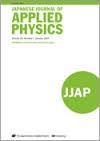电子回旋共振等离子溅射制备高硬度类富勒烯氮化碳薄膜的结构和键合状态
IF 1.8
4区 物理与天体物理
Q3 PHYSICS, APPLIED
引用次数: 6
摘要
采用电子回旋共振(ECR)溅射技术研究了纯碳膜和氮化碳膜。该方法的主要特点是在沉积过程中进行高密度离子照射,使纯碳膜具有类富勒烯(FL)结构,而不含氮。此外,在没有衬底加热的情况下,ECR溅射CN薄膜在中等氮浓度下表现出增强的FL微观结构和硬度与金刚石相当。这种微观结构由弯曲和交联的石墨烯片组成,由于sp3键合的增加,层状面积显著减少。在高氮浓度条件下,CN薄膜的硬度极低,因为腈键不仅降低了共价键的二维六边形网络,而且湮灭了那里的键。利用透射电子显微镜获得的晶格图像和x射线光电子能谱测量的键合状态,对ECR溅射CN薄膜进行了分类,并给出了相图和结构带图。本文章由计算机程序翻译,如有差异,请以英文原文为准。
The Structure and Bonding State for Fullerene-Like Carbon Nitride Films with High Hardness Formed by Electron Cyclotron Resonance Plasma Sputtering
We studied pure carbon films and carbon nitride (CN) films by using electron cyclotron resonance (ECR) sputtering. The main feature of this method is high density ion irradiation during deposition, which enables the pure carbon films to have fullerene-like (FL) structures without nitrogen incorporation. Furthermore, without substrate heating, the ECR sputtered CN films exhibited an enhanced FL microstructure and hardness comparable to that of diamond at intermediate nitrogen concentration. This microstructure consisted of bent and cross-linked graphene sheets where layered areas remarkably decreased due to increased sp3 bonding. Under high nitrogen concentration conditions, the CN films demonstrated extremely low hardness because nitrile bonding not only decreased the covalent-bonded two-dimensional hexagonal network but also annihilated the bonding there. By evaluating lattice images obtained by transmission electron microscopy and the bonding state measured by X-ray photoelectron spectroscopy, we classified the ECR sputtered CN films and offered phase diagram and structure zone diagram.
求助全文
通过发布文献求助,成功后即可免费获取论文全文。
去求助
来源期刊

Japanese Journal of Applied Physics
物理-物理:应用
CiteScore
3.00
自引率
26.70%
发文量
818
审稿时长
3.5 months
期刊介绍:
The Japanese Journal of Applied Physics (JJAP) is an international journal for the advancement and dissemination of knowledge in all fields of applied physics. JJAP is a sister journal of the Applied Physics Express (APEX) and is published by IOP Publishing Ltd on behalf of the Japan Society of Applied Physics (JSAP).
JJAP publishes articles that significantly contribute to the advancements in the applications of physical principles as well as in the understanding of physics in view of particular applications in mind. Subjects covered by JJAP include the following fields:
• Semiconductors, dielectrics, and organic materials
• Photonics, quantum electronics, optics, and spectroscopy
• Spintronics, superconductivity, and strongly correlated materials
• Device physics including quantum information processing
• Physics-based circuits and systems
• Nanoscale science and technology
• Crystal growth, surfaces, interfaces, thin films, and bulk materials
• Plasmas, applied atomic and molecular physics, and applied nuclear physics
• Device processing, fabrication and measurement technologies, and instrumentation
• Cross-disciplinary areas such as bioelectronics/photonics, biosensing, environmental/energy technologies, and MEMS
 求助内容:
求助内容: 应助结果提醒方式:
应助结果提醒方式:


